452 Search Results for visual supports
March 24, 2019
by Carole Zangari -
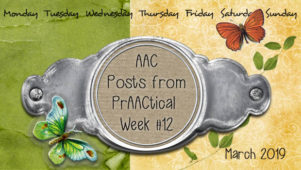
Happy Sunday, AAC friends! Here’s what we’ve been up to. Monday – PrAACtical Resources: Communication with Children with Deafblindness or Visual and Multiple Impairments Tuesday – AAC Link Up Wednesday – Video of the Week: AAC (Re)Boot Camp-It’s Not About the Technology Thursday – Using Generalization Probes to Gauge Language Learning in AAC :::::::::::::::::::::::::::::::::::::::::::::::::::::::::::::::::::::::::::::::::::::::::::::::::: We’ve been talking about AAC and book reading with some prAACtical friends this week. It seemed like a good time to share some book-related posts from the archives. 5 Ways to Use Books to Build Interaction with AAC Learners Alphabet Books and AAC Implementation Adapting Books with Visual Scenes Make It PrAACtical: Display Stand for Visual Supports or Books Using Adapted Books with AAC Learners: 3 Important Questions to Ask
March 21, 2019
by Carole Zangari -

In her role as the team’s SLP, Christy frequently collaborates with classroom teachers to identify areas of language development where students learning AAC need specific goals and instruction. Goals for her students address a range of areas. Given frequent aided language input, Evan will use 2-symbol sentences to make relevant comments at least twice per activity. When presented with preferred and non-preferred options, Sasha will independently request desired activities/objects with 70% accuracy. In the context of peer interactions, Tegan will ask a ‘What’ question in 3 out of 5 opportunities. Given gestural cues, Matthew will converse on a partner-selected topic for at least 4 conversational turns. With visual supports, Gabby will use subject + verb sentences to describe pictures, materials or events in 4 out of 6 trials. To help the students acquire these skills, Christy carefully plans the instructional sequence and selects contexts appropriate for the intervention targets. She... [Read More...]
January 14, 2019
by Carole Zangari -
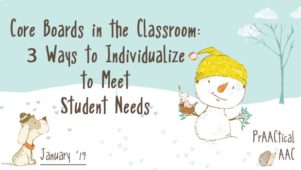
In the US, poster-sized core boards are displayed in a growing number of special education classrooms. In some cases, the displays match the AAC systems that were selected for the students following a comprehensive AAC evaluation. In others, they are more of a compromise measure which are used in order to get communication teaching started while the AAC evaluation process is still in progress. Either way, we eventually want to move from a one-size-fits-all approach to one where there are more individualized communication tools. Here are some of the key areas to consider in that process. Vocabulary: While there are many benefits of modeling and eliciting a starter set of core vocabulary throughout the day, there is no denying that specific words are very powerful. What other words (fringe or core), would make a difference in his/her/their learning trajectory? For some, we may consider adding things like the names of... [Read More...]
December 13, 2018
by Carole Zangari -
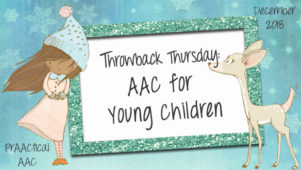
In recent weeks, we’ve been getting lots of questions about using AAC with young children. There are lots of ways to approach this so today we are looking back at some of our earlier posts on AAC at the preschool level. If this is a topic of special interest to you, don’t miss the announcement about a giveaway at the end of the post. Using Vest Displays with Preschoolers on the Autism Spectrum with guest author Dr. Carol Goossens’ Mining the Preschool Routine for PrAACtical AAC Opportunities Supporting Preschoolers with AAC Needs: A Case Study Visual Supports in Action in the Preschool Classroom TELL ME: AAC in the Preschool Classroom Attainment, the publisher of TELL ME (Teaching Early Language and Literacy through Multimodal Expression) is generously providing a free copy of the program through a contest they are running. TELL ME your AAC story for a chance to win a... [Read More...]
November 4, 2018
by Carole Zangari -
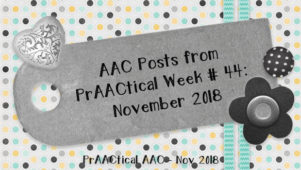
Happy November, AAC friends! Here are some posts you may have missed in your busy week. Monday – PrAACtically November: AAC Resources for a Year of Core Vocabulary Tuesday – AAC Link Up Wednesday – Video of the Week: Talk AAC with Me Thursday – Building AAC Facilitation Skills with Tabi Jones-Wohleber: MASTER PAL Training, Module 11 (Let the Child Lead) ::::::::::::::::::::::::::::::::::::::::::::::::::::::::::::::::::::::::::::::::::::::::::::::::::::::::::::::::::::::::::::::::::::::::::::::: Have room for a little more AAC in your day? Here’s a sampling to choose from. Beyond Behavior Problems: How Visual Supports Can Help Our AAC Teaching AAC Intervention: 5 Activities with PrAACtical Potential AACtual Therapy: Positive Behavior Management with Gail Bennell Daylight Savings Time and Behavior Extension Activities for AAC Practice And, finally, if working with young children who have complex communication needs is your thing, we invite you to join us for a full day of preschool AAC in January. (Use the sliding bar on the right to navigate... [Read More...]
October 22, 2018
by Carole Zangari -
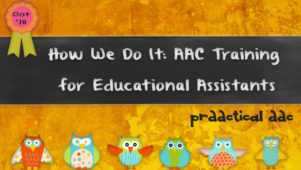
We’ve been focusing on training communication partners recently and today we’re focusing specifically on paraprofessionals/educational assistants. Our guest post is authored by SLPs Corinna Duffitt, M.Sc., RSLP (practicing for 21 years, 14 years in AAC) and Jennifer Wiegert, M.A., CCC-RSLP (practicing for 21 years, focusing on AAC for the past 6 years). They are colleagues on an AAC team with 4 other SLPs in a large school district in Surrey, BC, Canada. Their school district consists of 101 elementary schools and 20 secondary schools. Corinna and Jennifer are both passionate about giving children a voice and letting that voice uncovers their potential. They recently joined their private practice endeavours, outside of their public school positions, to form Chickadee AAC Communication Services. You can find them on Instagram (@chickadeeaacslps or #chickadeeaac), check in on their website, and/or follow them on Facebook. :::::::::::::::::::::::::::::::::::::::::::::::::::::::::::::::::::::::::::::::::::::::::::::::::::::::: AAC Training for Educational Assistants Some of the challenges we encountered... [Read More...]
October 7, 2018
by Carole Zangari -
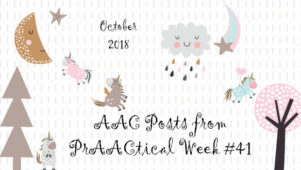
Happy Sunday, AAC friends! Here are some posts from the first week of AAC Awareness Month 2018. Take a look. Monday – Celebrating AAC Awareness Month 2018 Tuesday – AAC Link Up Wednesday – Video of the Week: The SLP’s Role in Cortical Visual Impairment Thursday – Building AAC Facilitation Skills with Tabi Jones-Wohleber: MASTER PAL Training, Module 7 Friday – PrAACtical Alert: Updated List of AAC App Discounts ::::::::::::::::::::::::::::::::::::::::::::::::::::::::::::::::::::::::::::::::::::::::::::::::::::::::::::::::::::::::::::::::::::::::::::::::: Can you squeeze in another AAC post or two? Here are a few suggestions. Using Structure to Minimize Behavioral Challenges Understanding Functional Communication Training PrAACtical Thoughts on Challenging Behavior and Emotional Regulation Parent-implemented Intervention for Challenging Behavior Ready/Not Ready: 5 Visual Supports for AAC Learners
October 1, 2018
by Carole Zangari -
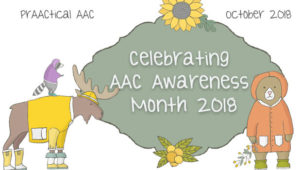
Let the celebrations begin! October is more than pumpkins and Halloween. It’s internationally recognized as AAC Awareness Month and it offers a wonderful opportunity for spreading the word as to how we can support people with complex communication needs. Looking for a few ideas that you can use in celebrating AAC Awareness Month? Here are a few to get you started. Light up your social media feeds with AAC Awareness messages. We’ve got some graphics to help you out. Here are some from previous years. You can also grab our 2018 Facebook banner here. Is Instagram your jam? We’ve got you covered. (Click on the image below to download.) Are you more of a Twitter fan? No worries. We’ve got something for you, too. (Click on the image below to download.) Make plans to attend ATIA 2019 for lots of AAC content. Early Bird conference registration closes on October 5 at 5 p.m.... [Read More...]
September 17, 2018
by Carole Zangari -
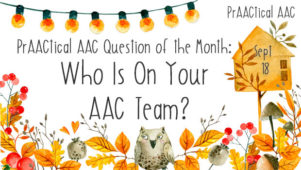
Once a month we like to turn the tables and see how PrAACtical AAC readers respond to a quick question. Our first AAC Question of the Month asked: What AAC skill is your biggest strength? Here’s how readers weighed in. Aided language input 38.1% Coaching communication partners 9.5% Assessment 8.3% Creating visual supports 7.1% Programming SGDs/AAC apps 6% Teaching early communicative functions 6% None, I don’t feel strong in any of these areas. 4.8% Collaborating with other service providers 3.6% Supporting AAC families 3.6% Report-writing and documentation 2.4% Supporting eye gaze users 2.4% Signing 1.2% PECS 1.2% Today, we turn our attention to AAC teams and who is one them. In the textbook, there are lots of disciplines listed but there is probably wide variability in which ones actually participate in AAC teams in different parts of the world. Take a minute, if you can, to tell us which... [Read More...]
September 6, 2018
by Carole Zangari -
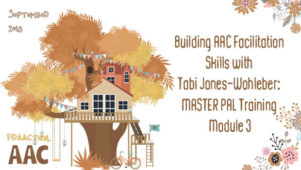
Our training series continues with West Virginia-based SLP Tabi Jones-Wohleber, who works with the AT Team for Frederick County Public Schools in Maryland and provides services to infants and toddlers in the West Virginia Birth to Three programs. In the first two posts, Tabi shared the Overview and Modeling modules and their accompanying resources. In today’s post, the training focuses on an important topic, motivation. ::::::::::::::::::::::::::::::::::::::::::::::::::::::::::::::::::::::::::::::::::::::::::::::::::::::::: Model as a MASTER PAL Module 3: Motivate Facilitator Guidelines Genuine motivation goes well beyond gummies and goldfish; reinforcers are only one small part of the picture as we endeavor to understand what truly drives an individual’s desire to learn and communicate. So much of the time it is the quality of the relationship and the meaningfulness of the interaction. This module discusses the importance of motivation in learning and engaging, whether intrinsic or extrinsic, as well as the undesirable consequences that occur when lack of motivation... [Read More...]









